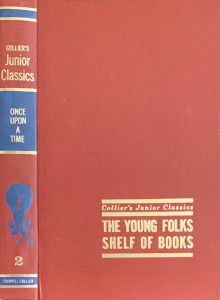Collier's Junior Classics (1962): Once Upon A Time

Editor:
Elizabeth H. Gross
Publication:
1962 by Crowell-Collier Publishing Company
Genre:
Anthology, Fables, Fairy Tales, Fiction, Folk Tales, Mythology, World Cultures
Series:
Collier's Junior Classics: The Young Folks Shelf Of Books (1962) ![]() Members Only
Members Only
Series Number: 2
Pages:
372
Current state:
This book has been evaluated and information added. It has not been read and content considerations may not be complete.
Book Guide
Search for this book used on:
Once Upon a Time
A blazing campfire . . . a busy marketplace . . . a village square . . . a quiet, shaded porch—these are the places where folk tales grow. From earliest times people made up stories of events that occurred in their families, their clans, their tribes, and eventually, their nations. These stories grew with the people. They were told by fathers to sons and spread by traveling minstrels and bards. For hundreds of years folk tales journeyed by word of mouth; no one ever wrote them down. Soon, there were thousands of tales that lived only in the minds of the people.
In the early 1800's the Grimm brothers traveled through Germany, collecting and writing the tales of the folk. They brought us Rapunzel, The Elves and the Shoemaker, and the many other Grimm tales. In other countries, too, collectors sought stories in the homes and haunts of the people. Together they have brought us a huge written literature of folk tales.
ONCE UPON A TIME is a collection of tales from twenty countries, with an added dash of fables and modern fairy tales. There are adventure tales, tales that teach a moral, tales that tell about silly people doing nonsensical things. There are stories about magic, stories about animals, and stories about bravery and courage. Whatever the topic, wherever the land of origin, folk tales have a universal appeal, for they are products of the people, read and loved by people everywhere.
ELIZABETH H. GROSS
Associate Professor,
School of Library Science,
Western Reserve University
To view an example page please sign in.
Resource Guide
Episode 70: Why Read Fairy Tales?
Released in 2020 by The Literary Life
Available formats: Streaming Audio
Length: 1 hr. 29 min.
View on the The Literary Life site
"Angelina Stanford and Cindy Rollins tackle the topic of fairy stories, discussing the what, why and how of reading them. Angelina shares the distinctive characteristics of fairy stories in contrast to other types of stories, such as myths. They deal with the question of whether fairy tales are 'escapist', the influence of the Grimm brothers scholarly work on interpreting fairy stories, and allowing the story to unveil its deeper truths without forcing meaning onto it.
Angelina gives an illustration of how to see the gospel messages in fairy tales by talking us through the story of Sleeping Beauty. She refutes the ideas that fairy tales are about human romance or are misogynistic. She also highlights some of the Enlightenment and Puritan responses to fairy tales that still linger with us today. Cindy and Angelina also discuss some common concerns such as the magical, weird, or scary aspects of fairy tales. Angelina also makes a distinction between folk tales, literary fairy tales, and cautionary tales."
Find This Book
Search for this book used on:


